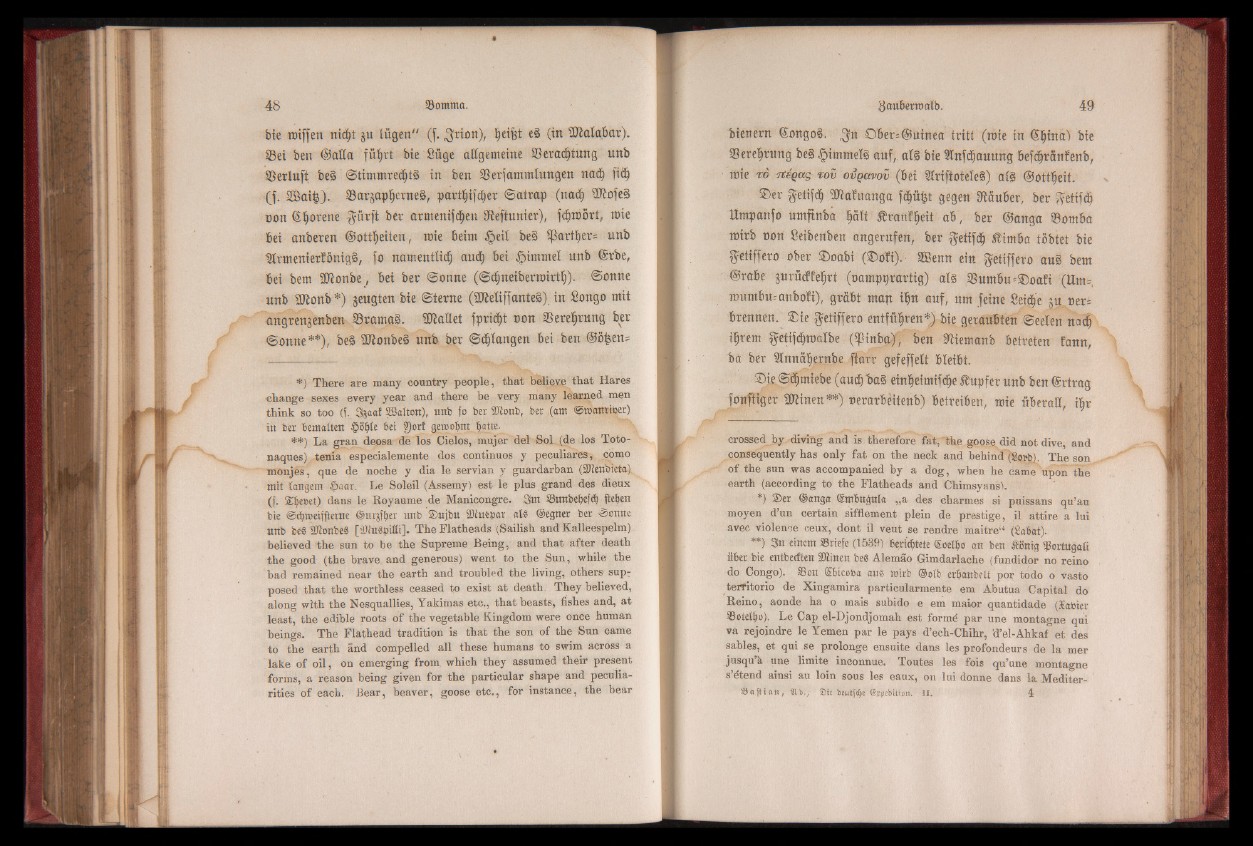
4 8 Somma.
bie raiffen nicfjt ¿u lügen“ (f. ^rtort), Reifet e§ (tu Sftalabar).
SBei ben ©alla fûljrt bie Sûge allgemeine 23erad)tung unb
©erluft beâ ©timmredjtâ in ben Serjammlungen nad) fÈ8)
(f. SEBai^J. ®arjap^erne§, partf»i[c^er Satrap (nadj fUîofeè
non ©fyorene $ürft ber armenifdjen 9teftunier), fcïpüôrt, raie
bei anberen ©ottlieiten, raie beim ¿peil be§ Sßarti)er= unb
Ulrmenieriônigê, fo namentlich auä) bei Rimmel unb ©rbe,
bei bem SDionbe, bei ber Sonne (Sdjneiberrairtïj). Sonne
unb Sftonb *) ¿eugten bie Sterne (2Jieliffante§) in Songo mit
angrenjenben Sramaê. f a l l e t fpridjt non ©erefjrung ber
Sonne**), be§ Eïïionbeê unb ber Schlangen bei ben @ö£eu=
*) There are many country people, that believe tha t Hares
change sexes every year and there be very many learned men
think so too (f. Sfoaaf SBaiton), unb fo ber 3Jiortb, ber (am ©roanriber)
in ber fcemalten bet S)ort geroobnt batte.
**) La gran deosa de los Cielos, mujer del Sol.(de los Toto-
naques) tenia especialemente dos continuos y peculiares, cpmo
monjes, que de noche y dia le Servian y guardarban (Sftenbieta)
mit iangem ftear. Le Soleil (Assemy) est le plus grand des dieux
(}. 2$e»et) dans le Royaume de Manicongre. 3m Snnbe^efcb Wen
bie ©djtrieiffierne ©urjfber unb ®ujbit iDiufcpar al8 ©egtter ber «soitne
unb beS 2Konfce§ [i)iu®piiii]. The Flatheads (Sailish and Kalleespelm)
believed the sun to be the Supreme Being, and tha t after death
the good (the brave and generous) went to the Sun, while the
bad remained near the earth and troubled the living, others supr
posed tha t the worthless ceased to exist a t death. They believed,
along with the Nesquallies, Yakimas etc., th a t beasts, fishes and, at
least, the edible roots of the vegetable Kingdom were once human
beings. The Flathead tradition is tha t the son of the Sun came
to the earth and compelled all these humans to swim across a
lake of o il, on emerging from which they assumed their present
forms, a reason being given for the particular shape and peculiarities
of each. Bear, beaver, goose etc., for instance, the bear
btettern ©ottgoS. ©Ber=®ittnea tritt (wie tn ©fjina) bte
fßerefjrung be§ ¿ptmmel§ auf, al§ bte fffufdjauung befd^ranfenb,
raie t o rteq c c s t o v o v q u v o v (Bei 2friftotele§) al§ ©ottljeit.
©er getifdj M u a n g a fdjü^t gegen Stäuber, ber fetifäj
Umpanfo umfinba ‘ Äran!$eit aB; ber ©anga Samba
rairb trau Seibenben angerufen, ber $etifdj itimba tobtet bie
$etiffero ober ©oabt (©oft). SBetttt ein getiffero au§ bem
©rabe ¿urüdffeljrt (oampprartig) al§ Sumbu=©oafi (Uttu,
raumBu.'anboii), gräbt map tfjtt auf, um feine Seicffe gu »er=
brennen, ©ie ftetiffero entführen*) bie geraubten ©eelen uatf)
ifjrem getifcfjroalbe (fßirtba), ben Stiemanb Betreten fann,
ba ber 2lnttüf)ernbe ftarr gefeffelt Bleibt.
©je ¡Säpntcbe (aucE)ba§ ein|eimifc§e Tupfer unb ben ©rtrag
fonftiger SDttuen**) uerarbeitenb) Betreiben, raie überall, iljr
crossed by diving and is therefore fat, the goose, did not dive, and
consequently has only fat on the neck and behind(got>b), The son
of the sun was accompanied by a dog, when he came upon the
earth (according to the Flatheads and Chimsyansï.
*) ®er ©anga ©tnbuguia „a des charmes si puissans qu’au
moyen d’un certain sifflement plein de prestige, il attire a lui
avec violence ceux, dont il veut se rendre maitre“ (gabat).
**) 3n eittem SSrtefe (1539) bericffiete ©oeïfjo an ben tbnig ^ortugaii
fiber bte entbecftett SDtinen beê Alemâo Gimdarlache (fundidor no reino
do Congo). SSon fëbicotoa ans ttnrb ©oïb erbanbett por todo o vasto
territorio de Xingamira particularmente em Abutua Capital do
Reino, aonde ha o mais subido e em maior quantidade (ïabter
SBotetbo). Le Cap el-Djondjomah est formé par une montagne qui
va rejoindre le Yemen par le pays d’ech-Chihr, 'd’el-Ahkaf et des
sables, et qui se prolonge ensuite dans les profondeurs de la mer
jusqu’à une limite inconnue. Toutes les fois qu’une montagne
s’étend ainsi au loin sous les eaux, on lui donne dans la Méditer-
B a ft i a i t , 21 b . , 3)ie beutjdje (Sjcpebiiion. I I . 4